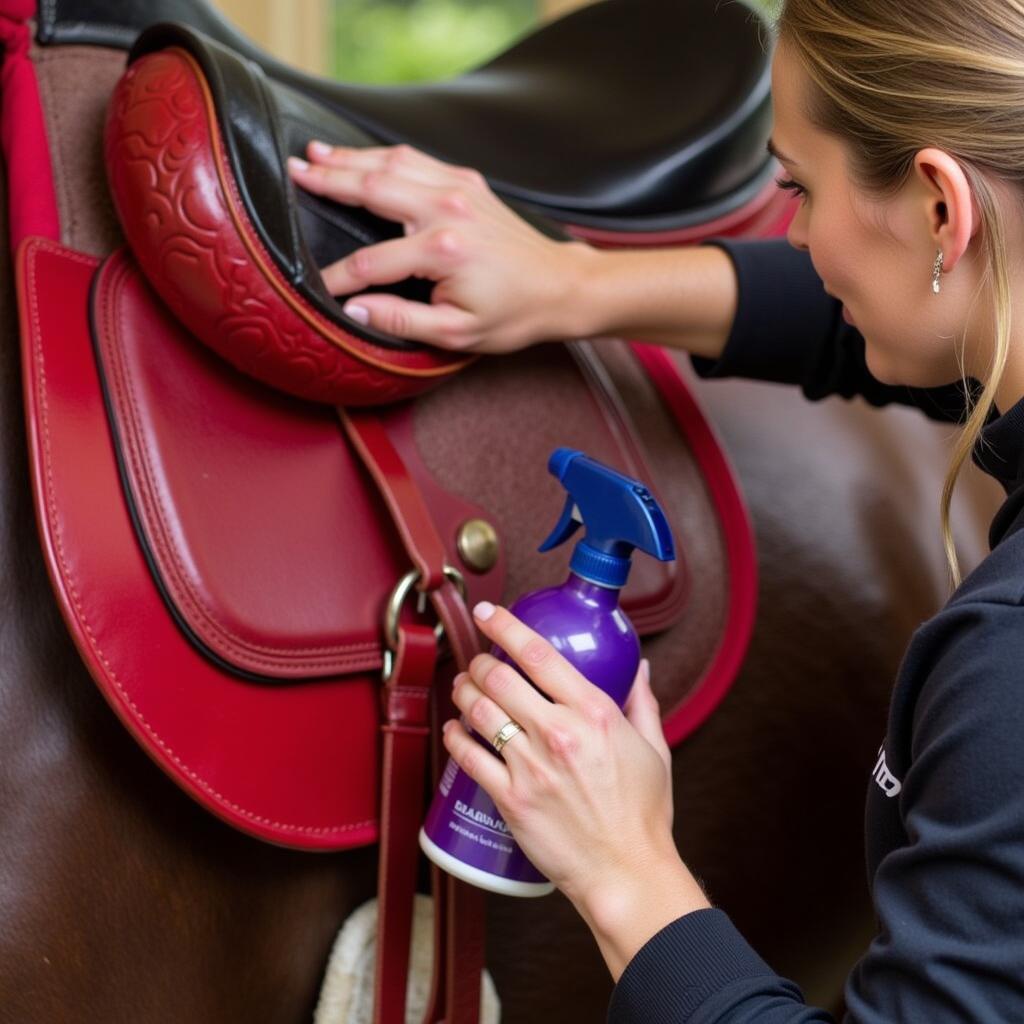Red Horse Tack Sets are a bold and stylish choice for any equestrian. They can add a touch of elegance and sophistication to your horse’s appearance, while also providing the necessary equipment for riding and training. But with so many different styles and materials available, choosing the right red horse tack set can be overwhelming.
This comprehensive guide will explore everything you need to know about red horse tack sets, from the different types of tack to the factors to consider when making your purchase.
Understanding the Different Types of Horse Tack
Before diving into the specifics of red horse tack sets, it’s crucial to understand the different types of tack and their purposes.
1. Bridles: The Essential Headgear
A bridle is the most critical piece of tack, providing control and communication between the rider and the horse. It consists of a headstall, bit, and reins.
- English Bridles: Characterized by their sleek and refined appearance, commonly used in English riding disciplines such as dressage, show jumping, and hunter/jumper.
- Western Bridles: Known for their durability and functionality, often feature a heavier design with a single rein and a prominent silver concho decoration.
- Hackamores: A bitless option that relies on pressure points on the horse’s face for control, suitable for horses with mouth sensitivities.
2. Saddles: Providing Comfort and Support
The saddle is the rider’s seat, designed to distribute the rider’s weight evenly across the horse’s back.
- English Saddles: Recognized by their lightweight design and close contact feel, allowing for greater freedom of movement for the horse.
- Western Saddles: Built for comfort and stability, featuring a deep seat, high cantle, and a horn for roping or balance.
3. Saddle Pads: Cushioning and Protection
Saddle pads are placed underneath the saddle to provide cushioning, absorb shock, and protect the horse’s back from rubbing.
- English Saddle Pads: Typically shaped to fit the contours of an English saddle, available in a range of materials like sheepskin, cotton, or synthetic fabrics.
- Western Saddle Pads: Larger and thicker than English pads, often made from wool, felt, or synthetic materials, designed to accommodate the larger surface area of a Western saddle.
Factors to Consider When Choosing a Red Horse Tack Set
Selecting the perfect red horse tack set requires careful consideration of several factors.
1. Discipline and Riding Style
The type of riding you engage in will significantly influence the style of tack you need.
- English Disciplines: English riders often prefer tack in black or brown leather, with red accents or stitching.
- Western Disciplines: Red tack is more common in Western riding, with shades ranging from bright cherry red to deep burgundy.
2. Horse’s Size and Conformation
Ensuring a proper fit is paramount for your horse’s comfort and well-being.
- Measure Accurately: Take precise measurements of your horse’s head, back, and girth to determine the correct size for bridles, saddles, and girths.
- Consider Conformation: Horses with high withers or short backs may require specially designed saddles for optimal fit and comfort.
3. Material and Quality
Horse tack is an investment, so choosing high-quality materials that can withstand wear and tear is essential.
- Leather: Full-grain leather is the most durable and long-lasting option, while top-grain leather offers a good balance between quality and affordability.
- Synthetic Materials: Synthetic materials like nylon and biothane are lightweight, easy to clean, and resistant to weather damage, making them a suitable choice for everyday use.
4. Style and Personal Preference
Red horse tack sets come in a variety of styles, from classic and traditional to modern and flashy.
- Embellishments: Consider the level of embellishment you prefer, whether it’s simple stitching, silver conchos, or intricate tooling.
- Color Coordination: Think about the overall aesthetic you want to achieve and how the red tack will complement your horse’s coat color and your riding attire.
Caring for Your Red Horse Tack Set
Proper care and maintenance are essential for preserving the beauty and longevity of your red horse tack.
- Regular Cleaning: Clean your tack after each use to remove dirt, sweat, and debris.
- Conditioning: Leather tack requires regular conditioning to keep it supple and prevent cracking.
- Storage: Store your tack in a cool, dry place, away from direct sunlight or extreme temperatures.
Frequently Asked Questions About Red Horse Tack Sets
1. What disciplines are red tack sets suitable for?
Red tack sets can be used in various disciplines, but they are more common in Western riding, particularly in rodeo events and trail riding.
2. Do red tack sets fade in the sun?
Yes, prolonged exposure to sunlight can cause red dye to fade over time. To minimize fading, store your tack indoors and consider using UV protectant sprays designed for leather goods.
3. Can I use red tack on a horse with sensitive skin?
While red dye itself isn’t inherently harmful, some horses may have sensitivities to certain dyes or chemicals used in the tanning process. It’s always best to choose high-quality tack from reputable brands and consult with a veterinarian if you have any concerns about your horse’s skin.
 Cleaning Red Horse Tack
Cleaning Red Horse Tack
Conclusion
Choosing the perfect red horse tack set is an exciting way to express your personal style and enhance your horse’s appearance. By considering your riding discipline, your horse’s needs, and your aesthetic preferences, you can find a set that is both functional and fashionable. Remember to prioritize quality, care, and proper fit to ensure your horse’s comfort and the longevity of your investment.
For personalized assistance in finding the ideal red horse tack set for your needs, contact Justus Horses USA at 0772127271, email us at [email protected], or visit our location at QGM2+WX2, Vị Trung, Vị Thuỷ, Hậu Giang, Việt Nam. Our dedicated team is available 24/7 to answer your questions and provide expert guidance.